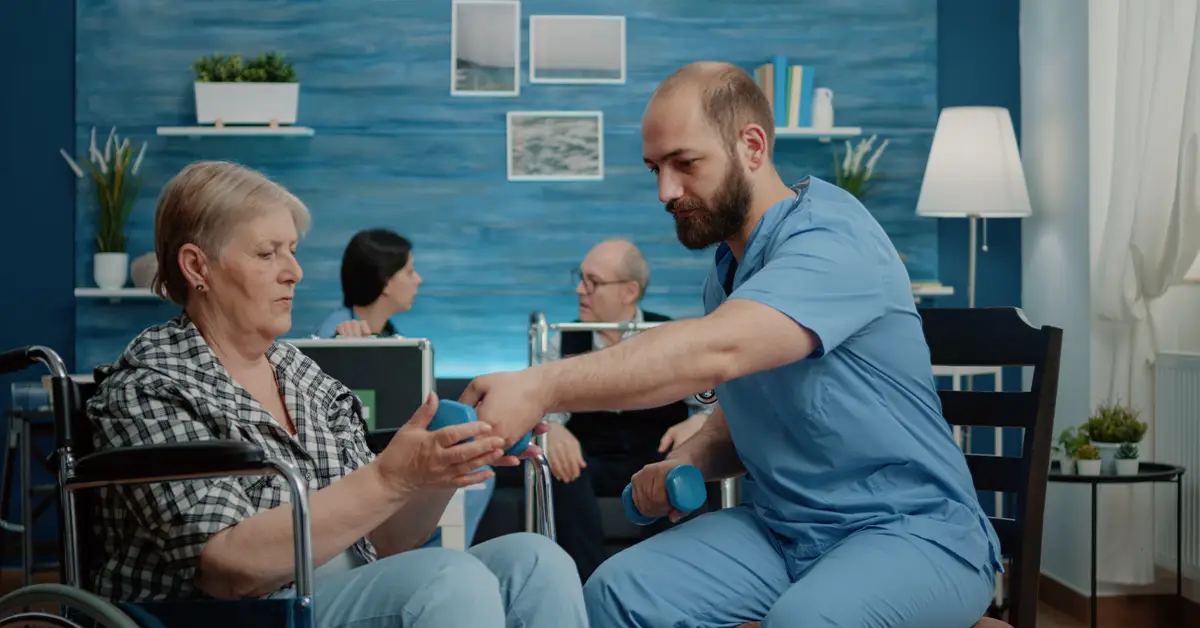The Chronic Care Model is a framework for delivering specialized care to people with chronic diseases. It helps healthcare providers ensure that patients receive the care they need to stay healthy and live independently.
Six in ten adults in the United States have at least one chronic disease, and four in ten have two or more chronic diseases. These conditions, such as stroke, diabetes, heart disease, cancer, and chronic kidney disease, are leading causes of death and disability. They also account for most of the nation’s $4.1 trillion costs in annual healthcare.
Given this situation, it is not surprising that the Chronic Care Model has become increasingly important for the entire health system. So, let’s talk about this care model and its key elements.
What Is the Chronic Care Model?
According to the Centers for Disease Control and Prevention (CDC), the Chronic Care Model (CCM) is a systematic approach to restructuring medical care designed to create partnerships between the health system and the communities they serve.
The Chronic Care Model is based upon the idea that people with chronic illnesses should have access to continuous care and support. It shifts the focus from acute and reactive care to proactive, population-based care. This includes regular contact with a primary care provider and access to self-management resources like patient education, support groups, and technology tools. The Chronic Care Model has key elements of a health system that promote high-quality chronic illness care such as self-management support, delivery system design, decision support, and clinical information systems.
In the Chronic Care Model, healthcare professionals need to clearly understand each patient’s specific needs and develop individualized care plans that address those needs. It also means that patients need to be involved in their own care and that they need access to ongoing support and resources.
By extending the Chronic Care Model to the millions of people living with chronic diseases, we can achieve long-term beneficial changes to population health and cost-related concerns within the health system.
Is The Chronic Care Model Effective in Managing Chronic Conditions?
Many studies and healthcare research findings show that a Chronic Care Model is an evidence-based approach to chronic illness care that can positively impact a patient’s well-being. Here are some of the evidence:
- In a 2009 study on the evidence of the Chronic Care Model in the new millennium, it was found that the Chronic Care Model can improve patient care and create better health outcomes. Some advantages include increased utilization of recommended therapies, shorter hospital stays, fewer emergency room visits, and better health outcomes.In the same study, it was found that the majority of randomized controlled trials of the Chronic Care Model showed improvements in patient well-being across a wide range of chronic conditions. This suggests that evidence-based care is an effective way to improve outcomes for patients living with chronic illnesses.
- In a 2013 study about diabetes management in US primary care settings, researchers found that the Chronic Care Model has effectively sustained diabetes care. Healthcare system leaders initiated system-level reorganizations that improved the coordination of diabetes care. Disease registries and electronic medical records were used to establish patient-centered goals, monitor patient progress, and identify lapses in care. Additionally, the study demonstrated that diabetes self-management education generally improved psychosocial and clinical outcomes in patients with diabetes.
- In a 2004 study by the Health Disparities Collaborative to improve diabetes care in Midwest community health centers, 19 health centers initiated a diabetes quality improvement effort based on a model that included rapid Plan-Do-Study-Act cycles from the continuous quality improvement field. In a Chronic Care Model that focused on its six vital elements, and an emphasis on patient self-management, researchers found that 90% of the participants said that the Diabetes Collaborative was worth the work and was a success.
What Is the History of the Chronic Care Model?
The Chronic Care Model was originally developed in the mid-1990s by a group at the MacColl Center for Health Care Innovation at Group Health Research Institute, led by Edward H. Wagner, MD, MPH.
This care model was refined in 1997 with input from a large panel of experts, and then tested nationally across various healthcare settings in 1998 as part of the program “Improving Chronic Illness Care” (ICIC) funded by The Robert Wood Johnson Foundation. In 2003, ICIC and a small group of specialists revised the model to add more detailed concepts for each of the six elements. We will discuss the six key elements of the Chronic Care Model in the next sections.
Several types of Chronic Care Models have been introduced and implemented globally. In 2002, the World Health Organization (WHO) introduced the Innovative Care for Chronic Conditions (ICCC) Framework, which emphasizes community and policy components of enhancing chronic disease health care.
The Chronic Care Model has been around for over two decades. It has been implemented in hospitals and clinics worldwide and has helped millions of patients get the care they need.
Why Is the Chronic Care Model Important?
The increasing prevalence of the chronic disease is a pressing global health issue. In both developed and developing countries, chronic illnesses are now the leading cause of death and disability. This has led to a renewed focus on the Chronic Care Model, which offers a potential solution to this growing problem.
The Chronic Care Model implementation is important because it emphasizes patient-centered care, patient empowerment, and self-management support. These components are essential for improving the health outcomes of people under chronic illness care. By providing patients with the necessary tools and support, healthcare providers can help them manage their conditions more effectively and improve their quality of life.
There is no one-size-fits-all solution to the problem of chronic disease. However, the Chronic Care Model offers approaches that could help us address this critical public health crisis.
What Are the 6 Key Elements of the Chronic Care Model?
The Chronic Care Model is a framework that identifies the essential elements of a health system that promotes high-quality chronic illness care.
Focusing on each of these areas will help to create significant improvements in the overall health outcomes of a patient with chronic illness. Here are the six key elements of the Chronic Care Model:
1. Self Management Support for People with Chronic Conditions
Patient self-management allows patients with chronic illnesses to control their health and be more active in their care. Patients are empowered to set their health goals, figure out health obstacles and challenges, and keep an eye on their conditions.
Self-management support is a critical part of the Chronic Care Model. Patients with chronic illnesses need ongoing support to manage their own care. Providing education and resources to help patients manage their conditions can improve outcomes and reduce costs.
In order to improve patient care, care teams should emphasize the patient’s central role in managing his or her own health. This means using effective self-management support strategies, including assessment, goal-setting, action-planning, problem-solving, and follow-up.
2. Delivery System Design to Improve Chronic Care
A well-designed delivery system is another important element of the Chronic Care Model. It is the key to providing effective, efficient chronic care. This system includes planned visits that prioritize the patient’s goals, which can help them stay in good health and make better use of health resources.
During the visits, roles are properly distributed among care team members, their interactions are planned to provide evidence-based care, and they deliver clinical case management services for patients with complex conditions.
In the delivery system design, care teams also ensure regular follow-ups and make sure the patients understand and agree with the care they give.
3. Decision Support for People with Chronic Diseases
Decision support includes providing clinicians with the information they need to make informed treatment decisions and helping patients understand their options and make informed decisions about their care.
Decision support in the Chronic Care Model enables clinicians to deliver care consistent with scientific data and patient preferences. Decision support provides clinicians convenient access to the latest evidence-based guidelines for the care of each chronic condition.
Educating clinicians regularly helps them follow these standards: use evidence-based guidelines in everyday clinical practice; share evidence-based guidelines and information with patients to get them involved; use proven methods for educating providers; and combine the expertise of specialists with primary health care.
4. Clinical Information Systems to Improve Care for Chronic Conditions
Clinical information systems help providers track patient progress and identify potential problems early on so they can take corrective action before things get out of hand. These systems also allow providers to share information quickly and easily, improving team communication and coordination.
Health systems use technology to make a comprehensive list, or a registry, of all the patients who have a certain chronic illness. The registry stores the information needed to keep track of a patient’s health and prevent problems.
Here are the advantages of clinical information systems in the Chronic Care Model:
- They provide providers and patients with timely reminders
- They identify relevant subpopulations for proactive care
- They make it easier to plan care for each individual patient
- They share information with patients and care providers to make sure care is well-coordinated
- They help monitor how well the practice team and care system are doing.
5. Organization of Healthcare to Improve Care for People with Chronic Diseases
For a health care system to have effective chronic illness care, it must be properly organized and managed. This includes creating dedicated teams of clinicians who are specifically responsible for caring for these patients, as well as ensuring that everyone involved has the necessary resources to do their job properly.
Chronic care and preventive care are important work, and they are something that the senior leadership needs to identify as a priority. They need to translate that priority into clear goals, which should be reflected in the health center’s policies, procedures, business plans, and financial planning. The entire organization needs to be on board with this effort, with senior leaders and clinician champions setting an example and providing the resources and support needed to get the job done.
Other change concepts included in Chronic Care Model elements are: providing incentives based on the quality of care; having open and systematic mitigation of errors and quality issues related to care; and getting agreements across the organization to facilitate care coordination properly.
6. Community Support for People with Chronic Conditions
Community programs and organizations can help or expand a health system’s care for people with chronic illnesses.
In this key element of the Chronic Care Model, health care organizations build strong alliances and partnerships with state programs, local agencies, schools, faith-based organizations, businesses, and clubs to receive community resources and improve the whole population’s health. Patients under chronic illness care are encouraged to engage in valuable community programs.
How does Chronic Care Management Fit into the Chronic Care Model?
Chronic care management (CCM) is essential to an effective Chronic Care Model. It refers to care coordination provided outside of the regular office visit for patients with multiple chronic conditions.
The Chronic Care Model is a framework for quality care, and chronic care management is the process through which many of its key elements are implemented. Chronic care management can help providers push past the barriers to care delivery and quality improvement. By coordinating care for patients with multiple chronic conditions, providers can help improve patient outcomes and reduce health disparities.
Chronic care management can be a critical piece of an overall strategy for improving care for chronic conditions. Fortunately, it has become easier in recent years, with Medicare now offering reimbursements for CCM services. We will talk about the CPT codes in the next sections.
What is Chronic Care Management?
Now that we’ve discussed the Chronic Care Model, let’s discuss Chronic Care Management (CCM). CCM is a service for patients with two or more chronic conditions. Under this program, care teams can bill for time spent managing patients’ health conditions.
CCM includes:
- Structured documentation of patient health information
- Comprehensive electronic care plans management
- Care transition management and other care management services
- Coordination and dissemination of patient health information inside and outside the practice
Unless otherwise specified, these CCM service elements can be used for both complex and non-complex CCM.
Outside of face-to-face patient visits, practitioners will typically provide CCM services and will focus on advanced primary care characteristics such as:
- Continuous patient relationship with the selected care team member
- Supporting patients in achieving health goals
- 24/7 patient access to care and health information
- Patients receiving preventive care
- Patient and caregiver engagement
- Prompt sharing and use of patient health information
What Chronic Conditions are Eligible for CCM?
Patients with multiple chronic conditions may be eligible for a CCM program. Eligible chronic conditions may include, but are not limited to: Alzheimer’s, dementia, arthritis, asthma, autism, cancer, cardiovascular disease, depression, diabetes, multiple sclerosis, lupus, high blood pressure, hypertension, and infectious diseases like HIV/AIDS.
To be covered under the CCM program, a patient’s condition must meet the following criteria:
- It must be expected to last for at least 12 months or until the patient’s death.
- It must be a condition that significantly increases the risk of death, functional decline, or exacerbation/decompensation.
In addition, a comprehensive care plan must be developed, monitored, implemented, and made available to patients for them to receive CCM services.
The program is offered through Medicare and is available to beneficiaries who have been diagnosed with one of these chronic conditions and who meet certain other criteria.
What are the Benefits of CCM?
CCM has a lot of benefits for both patients and healthcare providers. By providing ongoing care to patients with multiple chronic illnesses, healthcare providers can help improve the patients’ health outcomes and reduce the burden on our healthcare system. Here are the top benefits of CCM:
1. Chronic Care Management Allows Coordinated Care Across Multiple Teams.
CCM brings primary care physicians, specialists, home health agencies, and other providers to create a coordinated care plan for the patient. This enables better communication and collaboration among providers, improving care for the patient, especially for those under a complex CCM.
In addition, by coordinating care delivery across multiple teams, providers can avoid duplication of services and minimize the need for expensive medical tests and procedures. As a result, chronically ill patients can receive the best possible care at a lower cost.
2. Chronic Care Management Allows Easier Access to Healthcare.
CCM services solve many of the challenges patients face when accessing healthcare, such as discontinuity of care due to the shortage of primary care providers in remote areas, and limited practice hours in rural health clinics. It also helps overcome transportation barriers and allows patients to receive care in their homes.
3. Chronic Care Management Uses Technology for More Effective and Efficient Healthcare.
Technology has revolutionized the way we manage chronic care. For example, remote patient monitoring (RPM) can be used to track blood pressure, blood sugar, or other important health data. This information can then be remotely shared with doctors or nurses who can provide feedback and support.
Unlike traditional face-to-face visits, the patient can now be reached by the care team by phone, and the treatment plan can be updated using software or an app. CCM generally involves registered nurses who will phone the patient to check their condition, coordinate care, and offer coaching.
In addition, electronic health record (EHR) allows doctors to review a patient’s health history and medication management at a glance. This helps them make more informed decisions about treatment plans.
4. Chronic Care Management is More Cost-Efficient for Patients.
CCM services can lower costs by helping patients with certain lifestyle adjustments that lead to better control of their health and help them avoid emergency room visits and hospitalizations.
In some cases, CCM patients may not be taking their medications as prescribed, may not have had preventative screening checks in a while, or may not have disclosed additional social barriers that could be causing their health to deteriorate further. Providing coordinated treatment through CCM and using CPT 99490 (at least 20 minutes per month of clinical staff time directed by a physician or other qualified healthcare professional) can greatly enhance and impact behaviors contributing to non-compliance.
According to a report published by the Center for Medicare & Medicaid Innovation (CMMI), the program is attributed to reduced Medicare spending growth, hospital admissions, and improved patient connections to community-based resources. Over the 18-month study period, the CCM program lowered expenses by $74 per beneficiary per month (PBPM).
5. Chronic Care Management Allows Providers to Earn Recurring Revenue.
CCM may result in a considerable increase in revenue for providers. According to a 2015 study published in the Annals of Internal Medicine, healthcare practices that billed CPT code 99490 for CCM services provided by nonphysician healthcare practitioners (i.e., registered nurses, etc.) could expect a $75,000 increase in annual practice revenue if at least 50% of eligible patients enrolled in the program.
When CCM services are a part of a larger comprehensive care management program that includes remote patient monitoring (RPM), behavioral health integration (BHI), and other care management services, the value of providing CCM services to patients and providers will increase even more.
6. Chronic Care Management Promotes Higher Patient Engagement.
Chronic care management can also help to improve patient satisfaction and reduce hospital readmissions through personalized care plans and smooth care transitions. By providing CCM services, patients are more likely to take their medications as prescribed, follow up with recommended screenings and tests, and stay on top of their healthcare needs.
Which Payers Cover CCM Services?
CCM services are currently covered by payers like Medicare and Medicaid, with more expected to be added soon. It is important to check with your specific payer since the amount that is covered and the percentage of the covered bill varies from state to state.
The next section will discuss CPT codes and their national average reimbursement costs.
What Codes Do Providers Use to Bill for CCM Services?
Here’s the list of physicians and Non-Physician Practitioners (NPPs) who may bill for CCM services:
- Certified Nurse Midwives (CNMs)
- Clinical Nurse Specialists (CNSs)
- Nurse Practitioners (NPs)
- Physician Assistants (PAs)
According to Centers for Medicare and Medicaid Services guidelines, CCM services are commonly billed by primary care practitioners. However, some specialty practitioners may also furnish and bill them. Although CCM services are not within the scope of practice of limited-license physicians, and practitioners such as clinical psychologists, podiatrists, or dentists, CCM practitioners may refer to or consult with these practitioners to coordinate and manage care. The following are a list of billing codes pertinent to CCM:
- CPT Code 99491. Time spent by the billing practitioner. CCM services are provided directly by a physician or other qualified health care professional (QHP) to an eligible patient, requiring at least 30 minutes of a physician or other QHP time each calendar month. CPT Code 99491 allows for reimbursement of $86.17, per patient per month (PPPM) (non-facility national average).
- CPT Codes 99487, 99489, and 99490. Time spent directly by clinical staff to an eligible patient. Time spent by the billing practitioner may also count toward the time threshold if not used to report 99491.
- CPT Code 99487 – Complex chronic care management services, with the following, required elements: multiple chronic conditions expected to last at least 12 months, or until the death of the patient, chronic conditions place the patient at significant risk of death, acute exacerbation/decompensation, or functional decline, establishment or substantial revision of comprehensive care plan, moderate or high complexity medical decision making; first 60 minutes of clinical staff time directed by a physician or other qualified health care professional, per calendar month. CPT Code 99487 allows for a reimbursement of $134.27 PPPM (non-facility national average).
- CPT Code 99489 – Additional 30 minutes of complex CCM services of clinical staff time directed by a physician or other QHP of care coordination per calendar month (List separately in addition to code for primary procedure). CPT Code 99489 allows for a reimbursement of $70.60 PPPM (non-facility national average).
- CPT Code 99490 – CCM services time spent by clinical staff to an eligible patient (two or more non-complex conditions), directed by a physician or QHP, at least 20 minutes of time per calendar month. CPT Code 99490 allows for $64.02 in reimbursement, PPPM (non-facility national average).
How Do You Introduce CCM to Patients?
Chronic care management can be a daunting topic to discuss with your patients, but it is an important conversation. Here are a few tips on introducing CCM services to your patients.
- Start by explaining what CCM is and what it entails.
- Explain how the program will help them manage their condition and improve their quality of life.
- Be honest and open about the challenges of managing a chronic condition.
- Make sure patients are comfortable with having a care manager assigned to them.
- Explain who the care manager will be and what they will do.
- Offer your support and guidance throughout the treatment process.
- Let patients know they can contact the care manager anytime with questions or concerns and are welcome to participate in all aspects of their care plan.
Your patients may be hesitant to start CCM, but they must understand that this program will help them better control their conditions. The most important thing is to be patient and understanding with your patients. They are likely feeling overwhelmed and anxious about their health, so it is important to take the time to explain things in a way they can understand.
How Can Remote Patient Monitoring Help Improve Chronic Care Management?
Remote patient monitoring (RPM) is a health innovation in the telehealth industry, rapidly gaining ground in chronic care and disease management. It can be especially helpful for patients with cardiovascular disease, diabetes mellitus, asthma, etc.
RPM has already been proven effective in managing chronic care, especially in rural areas where access to specialist care can be difficult. DrKumo Inc., the leader in connected health technology, developed the world’s first RPM that supports disease management programs on a highly-secure cloud-based platform. It allows providers to monitor patients’ conditions remotely and in real-time and bridges the health disparities gap that often exists in rural areas.
RPM can also help to improve efficiency and communication in primary care practices. With RPM, primary care physicians can easily and quickly share information with specialists about their patients’ conditions. This expanded Chronic Care Model helps patients receive the most appropriate and timely care possible.
Takeaway
Health systems all over the world are already seeing improvements in care for patients with chronic disease through healthcare innovation like Remote Patient Monitoring for Chronic Disease Management. This is a crucial area of focus, as chronic conditions account for the majority of health expenditures and are the leading cause of death in many countries.
Chronic care management, when rooted in the Chronic Care Model, is a critical piece of an overall strategy to improve chronic care, and can help providers overcome some of the barriers to change. We must continue to work together towards improved care for patients with chronic conditions so that they can live healthier, more productive lives.
If you are a healthcare provider or a network of doctors looking for ways to revolutionize your chronic care management, join our RPM program now. Contact us for more details.








